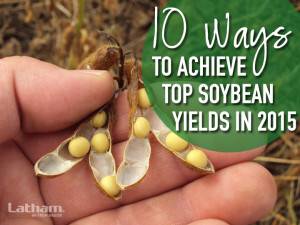Reach New Yield Levels in the New Year!
This time of year the headlines are filled with tips to help consumers reach their New Year’s Resolutions for “getting healthier” and “losing weight while eating great.” As seed product manager, I confess that my New Year’s Resolutions have more to do with achieving more rather than doing with less!
“Higher yield” tops my list for 2015. We’re encouraged by results from the 2014 F.I.R.S.T. Trials. Latham Hi-Tech Seeds won 38 location or regional summaries with 19 different products! We had 77 Top 3 finishes, 127 Top 5 finishes and 275 Top 10 finishes!
 One key to our success is working as a team to select products selected for local growing conditions. Our team approach includes working with Latham® dealers and customers in every region to conduct on-farm research. While we enjoy winning yield trials, we’re most interested in winning on your farm!
One key to our success is working as a team to select products selected for local growing conditions. Our team approach includes working with Latham® dealers and customers in every region to conduct on-farm research. While we enjoy winning yield trials, we’re most interested in winning on your farm!
Here’s my Top 10 List for how we can all achieve top soybean yields in 2015:
- Variety Selection: In my opinion, this is THE most important factor to achieving higher soybean yields. Farmers must manage a number of stress factors: disease, weeds, Soybean Cyst Nematodes, etc. Fortunately, many of these stress factors can be managed through careful variety selection. Many regions are experiencing weed resistance to glyphosate herbicides, so keep in mind that Latham has LibertyLink soybeans available.
- Seed-to-Soil®: Research shows correct product placement leads to a 3 to 7% yield improvement. Basing seed selection mostly on cost per bag and the size of the seed in the bag won’t add a single bushel to your overall yield. Understanding a particular product’s response to soil type or planting population, however, will! Get to know your local Latham® representative and work with him or her to develop a crop plan for success.
- Early planting: Soybeans are a light-sensitive crop, so it stands to reason that an earlier-planted crop has more potential for yield since it will have greater access to sunlight. However, there are risks associated with early planting. Protect early-planted soybeans from seedling diseases and insects by using seed treatments with either a fungicide or a fungicide-insecticide combination. Latham’s own SoyShield™ brand seed treatments are an excellent choice!
- Weed Management: Soybeans are very sensitive to early-season competition from grass and broadleaf weeds. Using a weed control program that includes a pre-emergence herbicide and a post-applied product reduces stress from weed pressure and allow for early canopy closure. An early complete canopy is important to intercept as much sunlight as possible throughout the growing season.
- Narrow Row Spacing: Based on the theory that enhanced yields are tied directly to the amount of light intercepted by the soybean crop, narrow row spacing can help close the canopy and allow for increased light interception. I strongly recommend that farmers take a look at row spacings in the 15- to 20-inch range. Over many years of field observations, this seems to be the range that affords the greatest amount of yield potential while also mitigating risks (such as White Mold) associated with drilled soybeans in the 7- to 10-inch range.
- Soil Fertility: When striving for higher yields, ensure adequate soil nutrients are available to achieve those yields or else all their careful planning and cultural practices will be for naught. Again, Latham’s Seed-2-Soil Nutrient Management program is invaluable to help farmers achieve these goals. Soil sampling, field mapping and nutrient recommendations are just three of the many benefits.
- Soybean Cyst Nematode: SCN is the number one pest of soybean fields in the United States. You really can’t even begin to think about raising 80 bushel per acre (bu/A) or even 60 bu/A soybeans until you know SCN populations are in each field. Nematodes tend to cause the most damage in drier years where soil moisture is lacking and plants are already under severe stress. 2012 was one of those years and we saw a significant amount of SCN damage that reduced overall yields. Here again, soil sampling and careful variety selection are critical.
- Crop Rotation: Many will argue this comment, but in my opinion, the corn-soybean crop rotation is still the most profitable practice for farmers over time. The long-term benefits of this rotation outweigh the short-term successes of corn-on-corn or even beans-on-beans.
- Scouting: Scouting your fields at least once a week is crucial. There will be times during the year when once a week isn’t often enough, and you might find yourself scouting fields every other day! Most land-grant universities support Extension programs in their respective states that give excellent advice on crop scouting.
- Inoculants: If soybeans haven’t been grown in a field for 4 or 5 years or if the soil is sandy, then inoculating the soybean seed should be seriously considered. Most fields in the Upper Midwest won’t require inoculants if they have been part of a corn-soybean rotation. Here again, scouting your fields, knowing your soils and digging up plants to assure proper nodulation is crucial for achieving top-end yields.